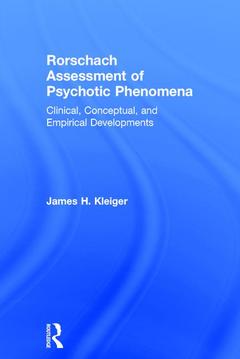Rorschach Assessment of Psychotic Phenomena Clinical, Conceptual, and Empirical Developments
Auteur : Kleiger James H.

Rorschach Assessment of Psychotic Phenomena takes the reader beyond where James H. Kleiger?s original work, Disordered Thinking and the Rorschach, left off. This new book offers readers a number of conceptual bridges between Rorschach characteristics commonly associated with psychotic phenomena and a range of psychological, neurocognitive, and psychoanalytic constructs that help psychologists move beyond static, test-bound interpretations of scores and indices.
Beginning with a broad-based understanding of disordered thinking and reality testing, Kleiger provides an updated review of the contributions of past Rorschach luminaries and contemporary figures who have helped make the Rorschach a robust tool for assessing aspects of psychotic-level experience. The contributions of major figures are highlighted and assessed in terms of their empirical, conceptual, and practical implications. In addition to providing a balanced, respectful review of each of these leading figures and the systems they developed, Kleiger offers a new way of organizing and conceptualizing what is currently understood about Rorschach scoring variables pertaining to psychotic phenomena. Kleiger?s aim is to help Rorschach practitioners not only consolidate their grasp of key scoring variables and what each means about an individual?s thought processes and internal experiences, but also expand their clinical understanding of the psychotic phenomena being assessed. He includes a wide range of psychotic phenomena, like negative symptoms, cognitive impairment, magical thinking, and impairment of insight, all of which are subjects of diagnostic interest when using the Rorschach with psychotically prone individuals.
The final section on psychopathology looks at how the Rorschach is useful in differential diagnosis of primary psychoses and those conditions that may include secondary psychotic phenomena. In step with contemporary DSM-5 standards, Kleiger organizes his discussion of severe psychopathology in a manner consistent with how psychotic phenomena are currently understood in the clinical and scientific literature. In addition to reviewing key clinical characteristics of these conditions, along with Rorschach contributions to the diagnosis of these disorders, he also focuses his lens on the Rorschach assessment of malingered psychosis and psychotic phenomena in children and adolescents.
Written with the same well-researched attention to detail and integrative style as Kleiger's earlier work, Rorschach Assessment of Psychotic Phenomena will prove invaluable to clinical psychologists, psychiatrists, and psychoanalysts interested in understanding and assessing psychosis.
LIST OF FIGURES
LIST OF TABLES
ACKNOWLEDGMENTS
FOREWORD
INTRODUCTION
PART I UNDERSTANDING AND ASSESSING PSYCHOTIC PHENOMENA
Chapter 1: Psychotic phenomena: Toward a conceptual understanding of reality testing and disordered thinking
Chapter 2: Assessing disordered thinking and Psychotic Phenomena
PART II RORSCHACH ASSESSMENT OF PSYCHOTIC PHENOMENA
Chapter 3: Herman Rorschach’s experiment
Chapter 4: Contributions of Rapaport and Holt
Chapter 5: The Thought Disorder Index
Chapter 6: The Comprehensive System and Rorschach Performance Assessment System
Chapter 7: Alternative Rorschach approaches for assessing disordered thinking
Chapter 8: Integrated model of Rorschach signs of disordered thinking
PART III DIMENSIONS OF DISORDERED THINKING
Chapter 9: Disorganization: Problems in focusing, filtering, and language usage
Chapter 10: Illogicality: Problems in reasoning and logic
Chapter 11: Impoverishment in thinking and language
Chapter 12: Awareness of perceptual and reasoning errors
PART IV DIFFERENTIAL DIAGNOSIS OF PSYCHOTIC PHENOMENA ON THE RORSCHACH
Chapter 13: Primary psychoses and the Rorschach
Chapter 14: Secondary psychotic phenomena and the Rorschach
Chapter 15: Malingered psychosis and disordered thinking
Chapter 16: Rorschach indications of psychotic phenomena in children and adolescents
FINAL THOUGHTS: EMPIRICAL, CONCEPTUAL, AND PRACTICAL CONSIDERATIONS
INDEX
James H. Kleiger is a psychologist-psychoanalyst in private practice in Bethesda, Maryland. He is a Fellow in the Society for Personality Assessment and Board Certified in Clinical and Personality Assessment Psychology. Kleiger has written Disordered Thinking and the Rorschach (1999) and was senior author of Assessing Psychosis: A Clinician’s Guide (2015), both by Routledge.
Date de parution : 02-2017
15.6x23.4 cm
Disponible chez l'éditeur (délai d'approvisionnement : 14 jours).
Prix indicatif 271,33 €
Ajouter au panierDate de parution : 02-2017
15.6x23.4 cm
Disponible chez l'éditeur (délai d'approvisionnement : 14 jours).
Prix indicatif 78,35 €
Ajouter au panierMots-clés :
Substance Induced Psychosis; Disordered Thinking; Psychoanalysis; Thought Disorder; clinical psychology; Inkblot Experiment; Rorschach; Critical Special Scores; Thought Disorder Scores; psychopathology; TDI Score; psychotic; FABCOM; psychosis; Thought Disordered Responses; Positive Thought Disorder; Psychotic Phenomena; Contaminatory Thinking; Formal Thought Disorder; Fabulized Response; Assessment Psychologists; Rorschach Assessment; Combinatory Thinking; Special Scores; Assess Thought Disorder; Confabulatory Thinking; INCOM; Drug Induced Psychoses; Playful Confabulations; PTI; Cognitive Disorganization



